2.1 Introduction : What is Climate Justice
Climate justice means everyone should share the fight against climate change fairly. In India, we’re one of the most affected countries—ranked seventh on the 2021 Global Climate Risk Index. But we can't ignore one fact : the average Indian emits just 2.1 tons of CO2 per year, way below the world’s 4.7 tons. So why do we suffer so much? Because the rich and big companies pollute the most, while common people pay the price.
This chapter is about fixing that unfairness and building a better system. We will do comparative study between good and crony capitalism. How people's perception and choice can save us from disasters of climate change. Why common people need to increase their carbon footprint, while imposing heavy climate taxes on the rich and crony capitalism or corporate.
2.2 The Carbon Divide: Common People vs. Crony Capitalism
Let think about a farmer in Bihar: he emits maybe 1 ton of CO2 a year—using a bicycle, cooking with wood. Now compare that to India’s richest 1%, who emit 53 tons each—21 times more! They fly private jets, live in AC mansions, and run factories that choke our air. Meanwhile, 363 million Indians can’t afford basics like electricity or a fan during 51°C heatwaves. Big companies get away with it—fossil fuel industries got ₹1.5 lakh crore in subsidies in 2022, while rural schools don’t even have power. This isn’t fair—it’s crony capitalism, where the rich get richer by polluting more.
Villagers of Hariharpur protesting on June 6, 2022, after the Chhattisgarh government gave its assent for clearing trees for the Parsa Open Cast Mining project in Hasdeo Arand.
On January 15, 2019, the Forest Advisory Committee of the Ministry of Environment, Forest and Climate Change (MoEF&CC) gave the Stage I, in-principle approval to divert around 800 hectares (ha) of forest land for mining the Parsa coal block in Hasdeo Arand forest area, in Surguja and Surajpur districts of Chhattisgarh .
Recent deforestation in Hyderabad's Kancha Gachibowli area, a 400-acre forested area near the University of Hyderabad, has sparked widespread protests and legal action. The Telangana government's decision to auction this land for IT and infrastructure projects led to the felling of over 40,000 trees, prompting the Supreme Court to intervene and halt the clearing activities.
Then, why should I ask a farmer or common people to decrease consumption, instead I will encourage them to increase consumption to touch dignity floor at least and have a sustainable life and enough earning without suffering from climate change and struggling for basic survival.
2.2.1 Why Common People Should Increase Carbon Footprint
Here’s a bold idea: the common Indian should use more carbon! Why? Because they need it to live better. In rural India, 85% don’t have ACs or fridges, even when it’s 51°C outside. They need electricity for fans, lights, and pumps to grow food. Denying them this while corporates pollute is like starving a child while the rich feast. India’s total emissions since 1850 are just 3.4% of the world’s—compare that to the US at 25%! Our people deserve to develop, but the big polluters should pay for it.
2.3 Why there is need of heavy taxes on corporates: A Path to Equity
For the first time in history, individual income tax collections exceeded corporate taxes (2024–25 estimates), which means common people now pay more than corporates in India.
In the fiscal year 2023-24, India's personal income tax collections, including the Securities Transaction Tax (STT), rose by 25% to ₹10.44 lakh crore, surpassing corporate tax collections, which increased by 10.26% to ₹9.11 lakh crore.
During Fiscal Year 2019–20, The government reduced the corporate tax rate from 30% to 22% for existing companies and to 15% for new manufacturing firms. This policy change led to a revenue loss of approximately ₹1.28 lakh crore. The revenue loss continued, amounting to over ₹1 lakh crore due to the sustained lower corporate tax rates.
The substantial revenue loss limits the government's capacity to invest in essential public services and infrastructure, which are crucial for sustainable development and climate resilience.
While corporations benefit from tax cuts, the middle class and lower-income groups continue to bear a disproportionate share of the tax burden through income taxes and indirect taxes like GST. Also, Corporate tax cuts failed to deliver promised job creation or green investment, undermining both economic equity and climate action.
Low tax-to-GDP ratio (11.7%) limits India’s ability to fund climate resilience, renewable energy, and public welfare programs whereas ratio for the UK and France exceeds 24%. India's tax authorities have issued substantial tax demands totalling over $2 billion to multinational companies, including Volkswagen, Kia, and Samsung, sparking concerns over the ease of doing business under Prime Minister Narendra Modi’s government.
We should slap a heavy carbon tax on them—say, ₹5,000 per ton of CO2 they emit. This money can fund solar panels for villages, heat-proof homes, and better schools. But right now, corporate bosses live large—flying private jets that emit 10 tons of CO2 per hour—while workers can’t afford a bus ticket. That’s not right. Tax the rich polluters and give back to the poor. Make them share the burden, not dump it on us.
2.4 The Madness of Ignoring Fairness: India’s Two Futures
The flowchart given below shows two paths India can take. “Bad Democracy” happens when we elect leaders controlled by crony and egoistic capitalists. These politicians let companies dominate, increasing carbon footprints while common people lack education and spiritual literacy and they face economic pressure. They get influenced and fooled by corporate influence, and climate change worsens—a “Cycle of Harm.”
Meanwhile, “Good Democracy” starts with leaders who serve the public. They regulate capitalism, promote education, and raise awareness. People then support sustainable choices, mitigating climate change—a “Positive Cycle.” People should be very cautious and wise to idolise right capitalist, influencer, and politician as inspirational leader otherwise they will get trapped in negative feedback loop.
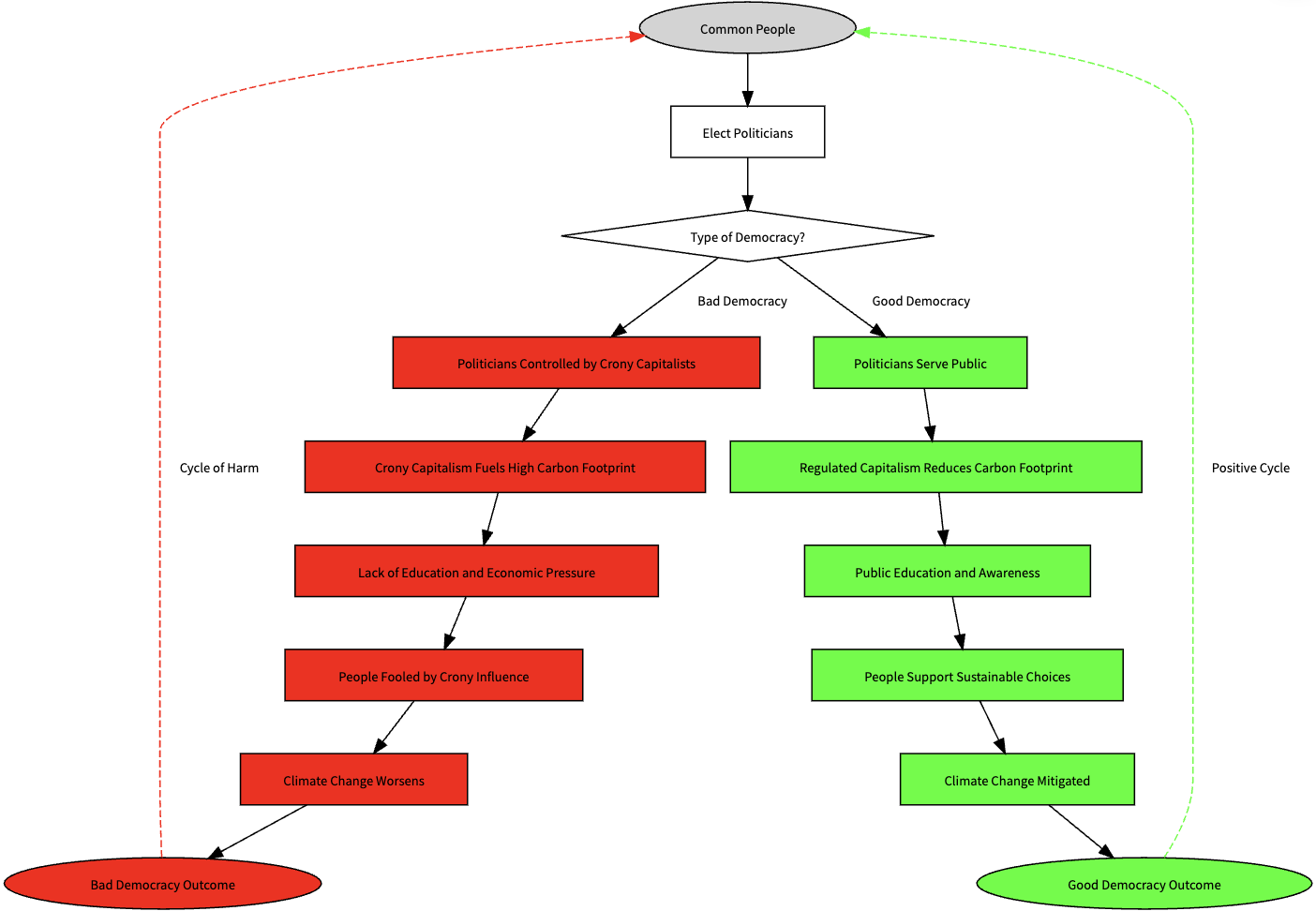
Right now, India is stuck in the harmful cycle. We celebrate 6-7% GDP growth, but climate change has already cost us 6-8% of GDP, and it could hit 35% by 2100. Who suffers most? The poor—50 million more could fall into poverty by 2030.
2.5 A Step to Achieve Carbon Equity by 2040 : Solution
The graph below shows what could happen if we act now. It tracks carbon footprints from 2023 to 2040 for the rich (top 10%), middle (next 40%), and poor (bottom 50%) in India. In 2023, the rich emit 35 tons per year—far above the “unsustainable” level of 8 tons including ultra-rich section emitting around 120 tons per year in India. The middle emit 10 tons, and the poor just 1 ton, below the “dignity floor” of 6 tons needed for a decent life.
By 2040, with carbon taxes, better public transport, EV adoption, energy access, and subsidies, the rich could drop to 10 tons, the middle to 7 tons, and the poor rise to 5 tons—closer to the global optimum of 6 tons. This shows we can balance carbon use: let the poor develop while making the rich polluters cut back. It’s a step toward “Good Democracy” and climate justice.
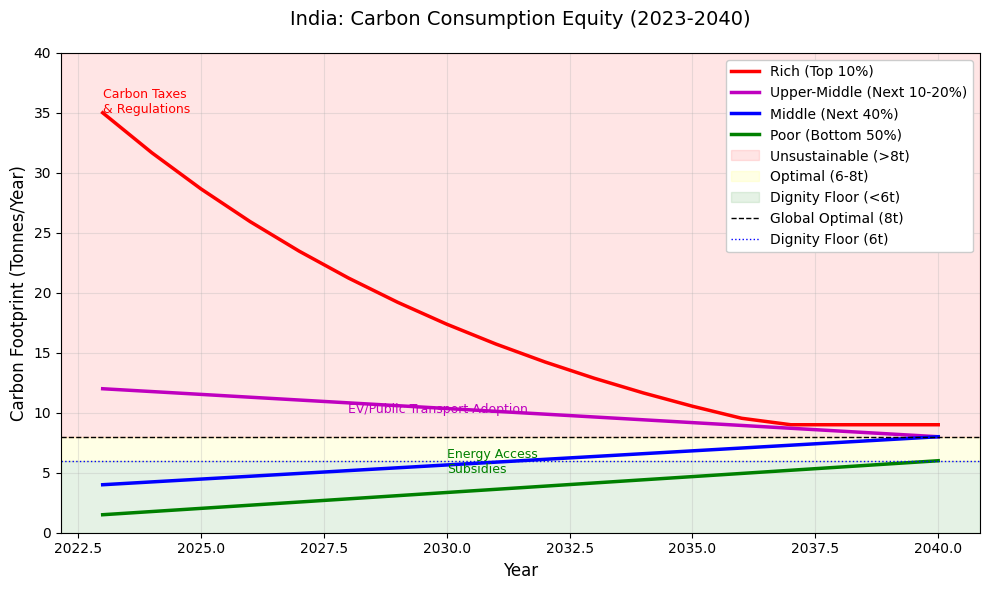
This graph shows India’s carbon consumption equity from 2023 to 2040. Policies can reduce the rich’s footprint while lifting middle and poor family's consumption to a dignified level.
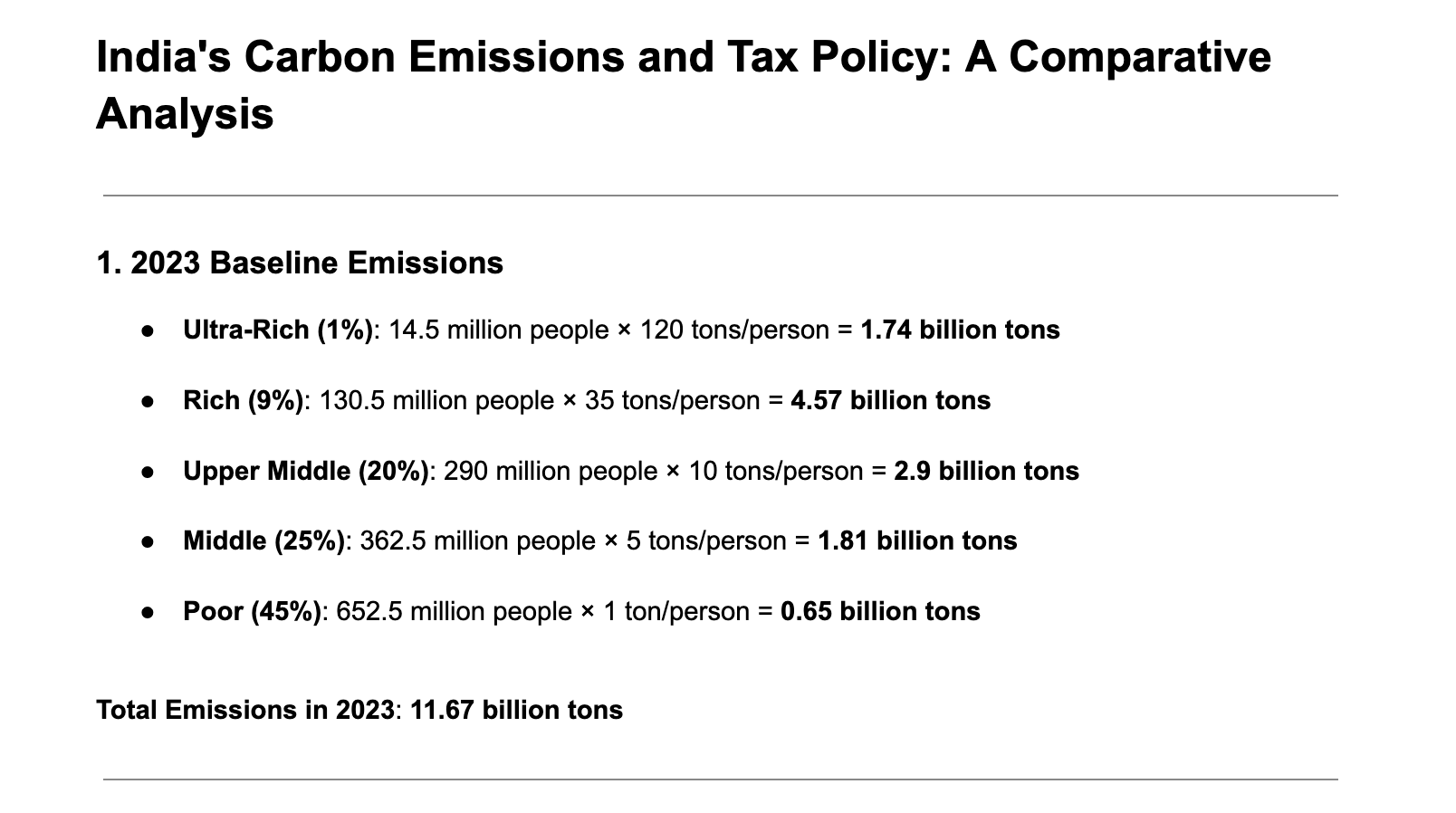
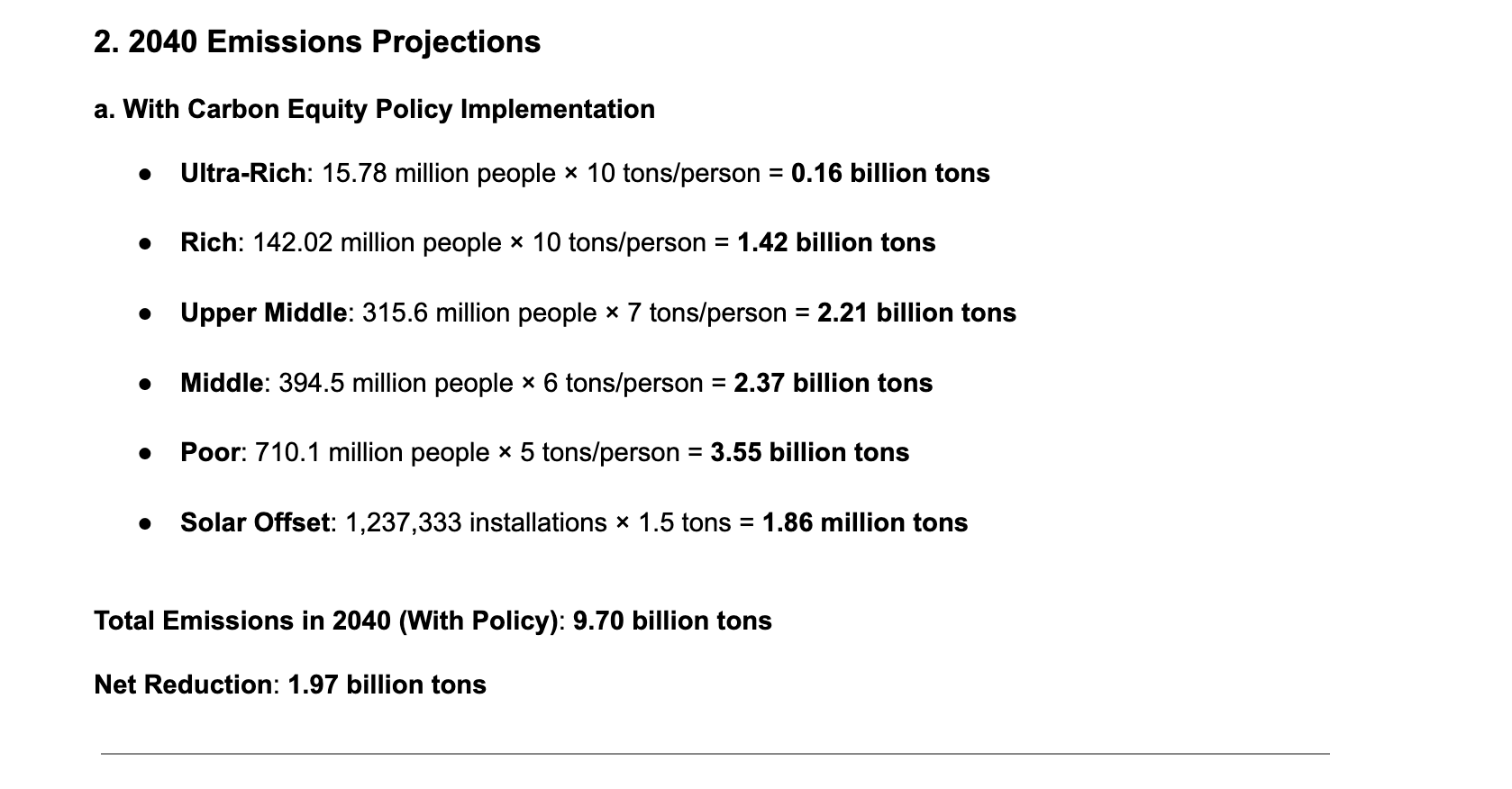
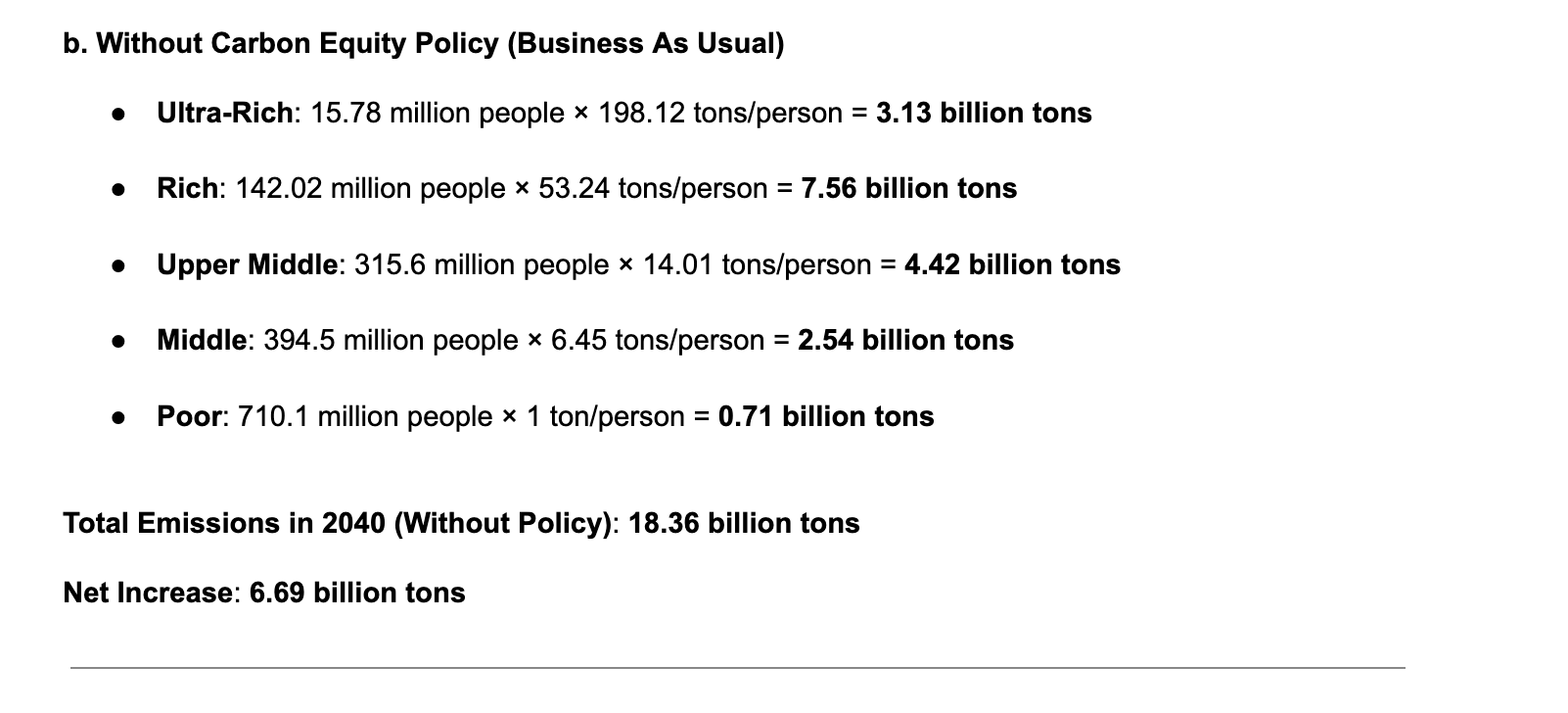

Conclusion we get from this calculation and table,
- With Policy:
- Net reduction of 1.970 gigatons reflects significant cuts for ultra-rich, rich, and upper middle, offset by increases for poor and middle to reach dignity floor.
- Solar offset (1.856 million tons) supports the increase for the poor and middle.
b. Without Policy:
- Net increase of 6.691 gigatons driven by unchecked growth in emissions from ultra-rich, rich, and upper middle, with minimal change for the poor.
The policy of carbon equity help to avoid increase of carbon emission by 8.660 gigatons by 2040 such that :
= 6,691,159,400−(−1,969,656,000)
= 8,660,815,400 ton
Conclusion

Climate justice isn’t just a fancy word—it’s survival. We need policies that let common people grow without guilt, while making big polluters pay up.
Demand transparency: who’s emitting what? Support local solar projects in your village.
Let’s fight for a fair future, not a rich man’s game. Can India choose “Good Democracy” to tackle climate change? Tell me what you think!
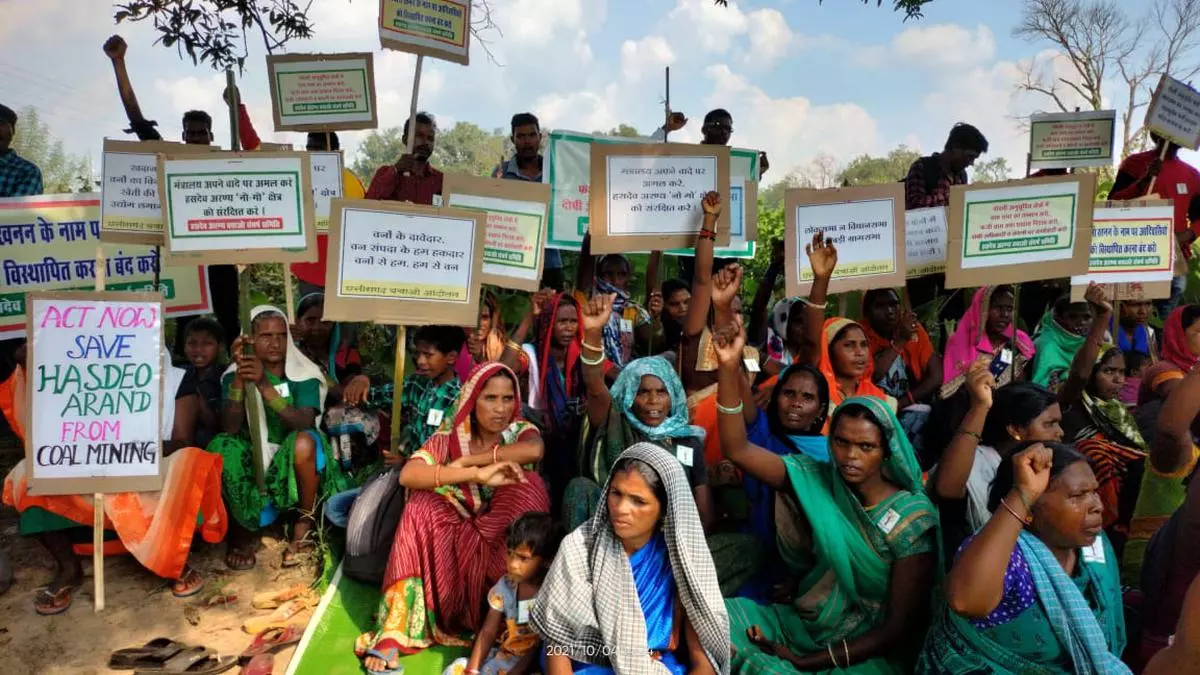
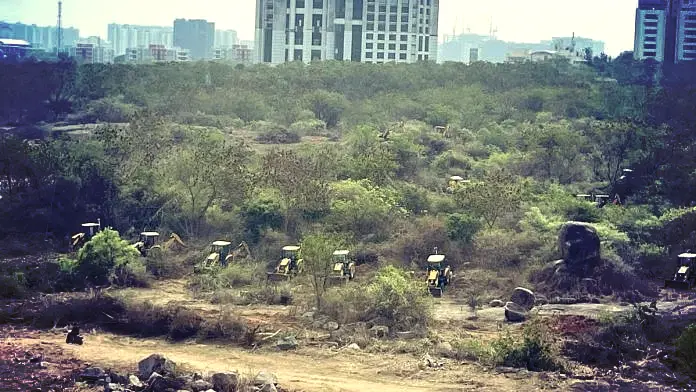
Chapter 2 : Climate Justice and Carbon Management in India